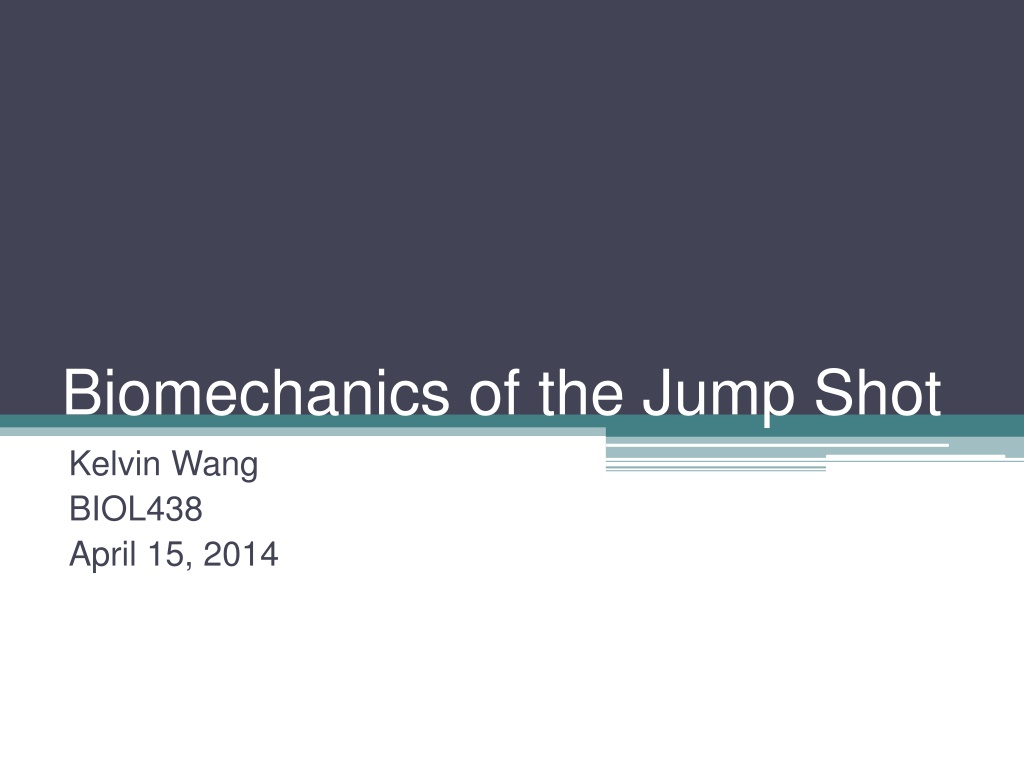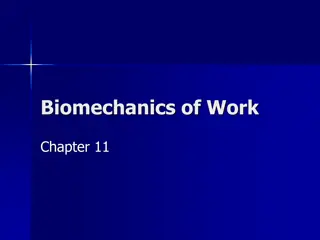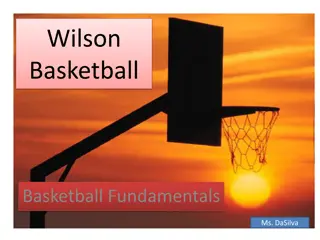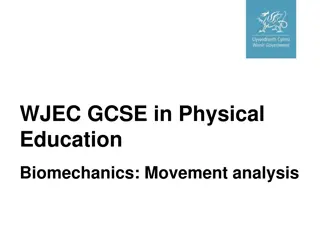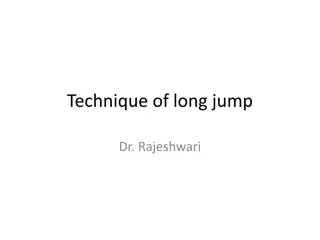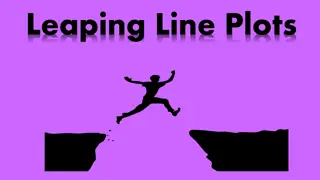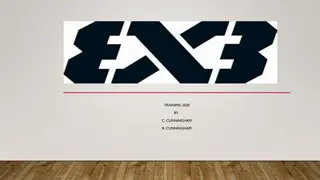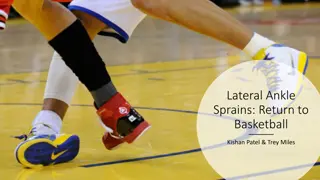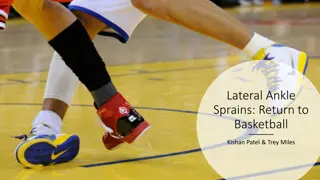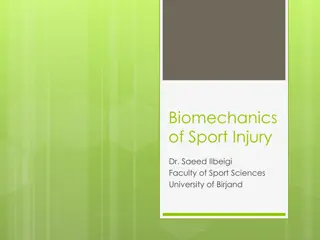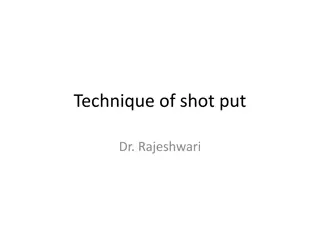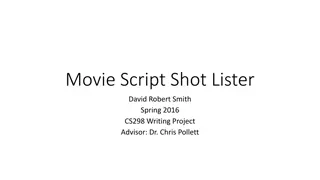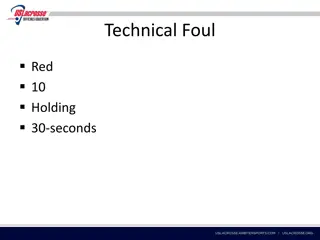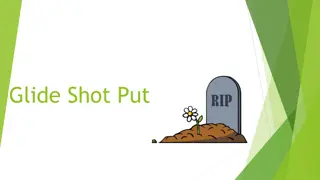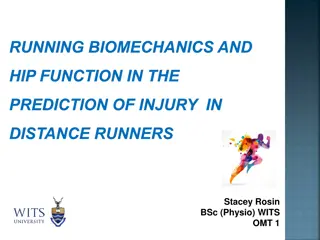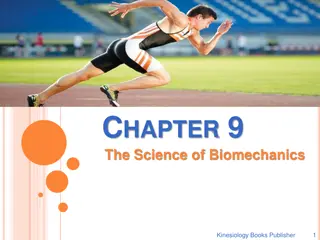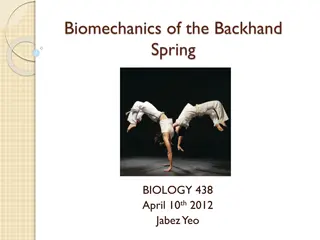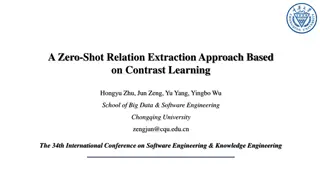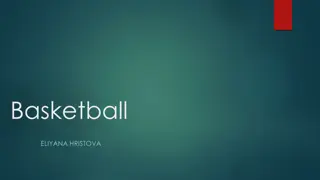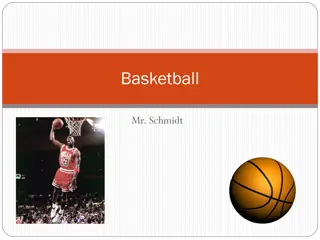Understanding Biomechanics of the Jump Shot in Basketball
Explore the biomechanics behind the jump shot in basketball, covering techniques, muscle engagement, shot mechanics, and analysis of momentum and energy. Learn about the phases involved, muscle groups utilized, and the physics governing a successful jump shot. With insights into movement patterns and energy transfer, enhance your understanding of this fundamental skill in basketball.
Download Presentation

Please find below an Image/Link to download the presentation.
The content on the website is provided AS IS for your information and personal use only. It may not be sold, licensed, or shared on other websites without obtaining consent from the author. Download presentation by click this link. If you encounter any issues during the download, it is possible that the publisher has removed the file from their server.
E N D
Presentation Transcript
Biomechanics of the Jump Shot Kelvin Wang BIOL438 April 15, 2014
Technique3 Phases Preparation balance, center of mass over support Execution jump and shoot, release Follow Through landing, balance, center of mass over support over support Preparation balance, center of mass over support Execution jump and shoot, release Follow Through landing, balance, center of mass Source: The Seattle Times Preparation Execution Follow Through
TechniqueMuscles Used Hip extension hamstrings (biceps femoris, semitendinosus, semimembranosus), gluteus maximus Fast-twitch higher vmax, higher power, more efficient at higher velocity Knee flexion/extension quadriceps muscle eccentrically contracts in preparation, during jump it concentrically contracts Slower-twitch lower vmax, more economical, recruit more motor units Gastrocnemius (fast-twitch) plays role Source: www.oxford174.com
TechniqueMuscles Used Shoulder upward rotation middle and lower trapezius muscles, rhomboids, deltoids Elbow flexion/extension eccentric contraction of triceps, then concentric to generate force Fast-twitch fibers for greater power Wrist extension/flexion add spin, velocity to ball Fast-twitch fibers Source: www.rci.rutgers.edu Source: www.endoszkop.com
3 Shots Source: www.lakernation.com Source: ESPN Source: wikiHow
Normal Jump ShotMomentum Before release, triceps extension (assume zero initial momentum): a = v/ t = 51.39 m/s2 (from LoggerPro) F = ma = (0.62 kg)(51.39 m/s2) = 31.86 N t = 0.096 s, so: J = F t = 3.06 kg-m/s At release: vx,ball = 4.40 m/s Total velocity = 7.18 m/s Assume mball = 0.62 kg, then: p = mv = (0.62 kg)(7.18 m/s) = 4.45 kg-m/s vy,ball = 5.68 m/s Thus, the triceps extension motion for shooting the ball imparts 3.06 kg-m/s impulse to the ball from preparation phase to release. Wrist flick motion gives ball extra velocity and could account for the difference in impulse momentum.
Normal Jump ShotWork and Energy Kinetic energy = 0.5mv2 At release: KE = 0.5(0.62 kg)(7.18 m/s) 2 = 15.99 J Work = Energy = 15.99 J (assume E0 = 0) From the start of triceps extension to release: Power = Work/ t = 15.99 J/0.096 s = 166.6 W
Pull-up Jump ShotMomentum Before release, triceps extension (assume zero initial momentum): a = v/ t = 139.9 m/s2 (from LoggerPro) F = ma = (0.62 kg)(139.9 m/s2) = 86.74 N t = 0.04 s, so: J = F t = 3.47 kg-m/s At release: vx,ball = 4.70 m/s Total velocity = 7.81 m/s Assume mball = 0.62 kg, then: p = mv = (0.62 kg)(7.81 m/s) = 4.84 kg-m/s vy,ball = 6.24 m/s Thus, the triceps extension motion for shooting the ball is quicker, and imparts 3.47 kg-m/s impulse to the ball from preparation phase to release. Wrist flick motion gives ball extra velocity.
Pull-up Jump ShotWork and Energy Kinetic energy = 0.5mv2 At release: KE = 0.5(0.62 kg)(7.81 m/s) 2 = 18.91 J Work = Energy = 18.91 J (assume E0 = 0) From the start of triceps extension to release: Power = Work/ t = 18.91 J/0.04 s = 472.75 W
Fadeaway Jump ShotMomentum Before release, triceps extension (assume zero initial momentum): a = v/ t = 83.2 m/s2 (from LoggerPro) F = ma = (0.62 kg)(83.2 m/s2) = 51.58 N t = 0.08 s, so: J = F t = 4.13 kg-m/s At release: vx,ball = 3.88 m/s Total velocity = 8.02 m/s Assume mball = 0.62 kg, then: p = mv = (0.62 kg)(8.02 m/s) = 4.97 kg-m/s vy,ball = 7.02 m/s Thus, the impulse from triceps extension is similar to a normal jump shot, and imparts 4.13 kg-m/s impulse (more than normal or pull-up) to the ball from preparation phase to release.
Fadeaway Jump ShotWork and Energy Kinetic energy = 0.5mv2 At release: KE = 0.5(0.62 kg)(8.02 m/s) 2 = 19.94 J Work = Energy = 19.94 J (assume E0 = 0) From the start of triceps extension to release: Power = Work/ t = 19.94 J/0.08 s = 249.25 W
Normal 3.05 kg-m/s 4.34 kg-m/s 31.6 N 16.03 J 159.6 W Pull-up 3.46 kg-m/s 4.85 kg-m/s 89.2 N 19.31 J 471.8 W Fadeaway 4.17 kg-m/s 4.96 kg-m/s 52.6 N 19.83 J 273.4 W Impulse Momentum Force Energy Power Fadeaway jump shot gives more impulse to shot from triceps extension Higher proportion of momentum is from triceps, less from wrist flick
Normal 3.05 kg-m/s 4.34 kg-m/s 31.6 N 16.03 J 159.6 W Pull-up 3.46 kg-m/s 4.85 kg-m/s 89.2 N 19.31 J 471.8 W Fadeaway 4.17 kg-m/s 4.96 kg-m/s 52.6 N 19.83 J 273.4 W Impulse Momentum Force Energy Power Pull-up jump shot results in more force in shooting the ball Running start could have effect Force 100 Force (N) 50 0 Normal Pull-up Fadeaway
Normal 3.05 kg-m/s 4.34 kg-m/s 31.6 N 16.03 J 159.6 W Pull-up 3.46 kg-m/s 4.85 kg-m/s 89.2 N 19.31 J 471.8 W Fadeaway 4.17 kg-m/s 4.96 kg-m/s 52.6 N 19.83 J 273.4 W Impulse Momentum Force Energy Power Normal jump-shot results in least kinetic energy to the ball Pull-up: running start helps transfer momentum higher velocity at release higher kinetic energy Fadeaway: adjusting for defender shoot ball faster vertically Kinetic Energy 25 Kinetic Energy (J) 12.5 0 Normal Pull-up Fadeaway
Normal 3.05 kg-m/s 4.34 kg-m/s 31.6 N 16.03 J 159.6 W Pull-up 3.46 kg-m/s 4.85 kg-m/s 89.2 N 19.31 J 471.8 W Fadeaway 4.17 kg-m/s 4.96 kg-m/s 52.6 N 19.83 J 273.4 W Impulse Momentum Force Energy Power Pull-up jump shot results in most power greater energy (increase W) and shorter release time (decrease t) Power 500 Power (W) 250 0 Normal Pull-up Fadeaway
Conclusions Fadeaway jump shot: more triceps used, faster twitch muscles to generate greater impulse Efficient and economical, but difficult to execute Pull-up jump shot: greater force and greater power on shot, due to running start However, relies on running start sudden stop and jump. Slower twitch muscles in leg are less economical at higher contraction speeds fatigue Normal jump shot: least energy, force, and power produced, but not as tiring
References Alexander, M. (1990). The application of biomechanics to basketball skills. CAHPER Journal, 56(3), 4-10. Haefner, J. (2008). Proper Basketball Shooting Technique, Fundamentals, and Form. Retrieved from http://www.breakthroughbasketball.com/fundamentals/shooting- technique.html Okazaki, V. H. A., & Rodacki, A. L. F. (2012). Increased distance of shooting on basketball jump shot. Journal of Sports Science and Medicine, 11, 231-237 Valente, R. (2010). Movement Phase. Jump Shot. Retrieved from http://valentejumpshot.blogspot.com/20 10/10/movement- phase.html Quist, J., VanNostrand, Z., Burns, B. (2012). Science of the 3-Point Shot. Biomechanics of a 3-Point Shot. Retrieved from https://sites.google.com/site/biomechanicszjb/science-of-the-3
